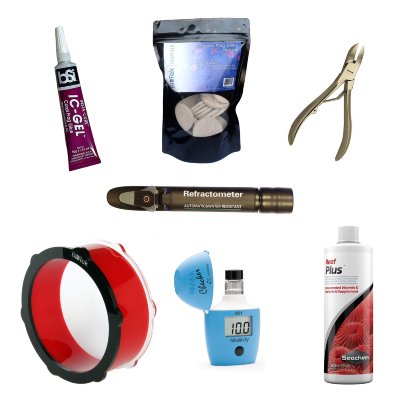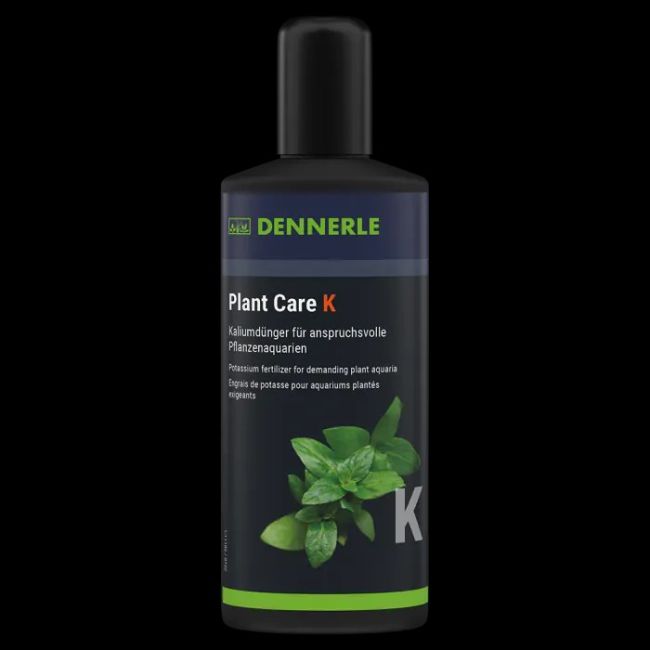We use cookies to make your experience better. To comply with the new e-Privacy directive, we need to ask for your consent to set the cookies. Learn more.
Dennerle Plant Care K, 250ml
Dennerle Plant Care K 250ml liquid solution is a potassium fertilizer for heavily planted aquariums.
Potassium Liquid Fertilizer for Demanding Planted Aquariums
Dennerle Plant Care K is a potassium fertilizer for heavily planted aquariums.
Highlights:
- Potassium fertilizer for heavily planted aquaria
- For the targeted supply of potassium
- For splendid plants and intensely bright colors
- High reach due to concentrated active ingredients
- Scientifically tested and optimized
Potassium Macro-nutrient Fertilizer for Planted and Demanind Aquariums
For aquarium plants to grow healthily, they require about 20 different nutrients. One of the most essential nutrients is potassium, which falls under the category of macronutrients and is needed by plants in larger quantities. Potassium, along with nitrate and phosphate, as well as light and CO2, plays a crucial role in achieving balanced and healthy plant growth.
What is Potassium Needed for in the Aquarium?
Potassium plays a vital role in a plant's functions. It is found in high concentrations in both the cells and the vascular system. As an osmotically active ion, it helps build root and cell pressure. Additionally, it is involved in various metabolic processes, including the production of sugars, starch, cellulose, and lignin. Plants can store and transport potassium as needed, typically from older to younger leaves. The amount of potassium in tap water depends on its hardness. To find out the content in your local area, ask your water supplier. In aquariums, potassium enters in small quantities through food and fish waste. Good aquarium fertilizers, such as Dennerle Plant Care Pro, contain an appropriate amount of potassium, which is typically sufficient for normal, planted community aquariums. However, demanding planted aquariums, such as aquascaping and Holland aquaria, require above-average nutrient levels, especially macronutrients. These aquariums are characterized by:
- dense planting (more than 70–80% of the bottom surface)
- many fast-growing species
- plenty of light (30–60 lumen/liter or more)
- CO2 fertilization
- 30–50% partial water changes per week
- no or low fish stocking (but with shrimps)
Detect Potassium Deficiency in the Aquarium
Potassium deficiency may occur in certain types of aquariums, especially those with soft water, and it mainly affects the older leaves. When necessary, the element is transported from the older leaves to the younger leaves through the vascular system. The most common symptoms are yellowing (chlorosis), which can appear in spots or over a large area between the leaf veins, or at the leaf margin. Later on, the tissue dies in spots or areas (necroses). Some plants are more sensitive to low levels of potassium, such as the parrot leaf (Alternanthera) and the cognac plant (Ammania), which can experience sudden growth stall and produce crippled leaves. In the case of the Indian water plant (Hygrophila polysperma), small black spots (necroses) appear on the older leaves in case of potassium deficiency.
Remedy Potassium Deficiency in the Aquarium
To ensure optimal growth in demanding plant aquaria, it is important to monitor potassium levels and supplement as needed. The amount of nutrients required for each aquarium varies based on plant quantity, species, animal stocking, feeding, water changes, and growth conditions such as light quantity, CO2 addition, and filter technology. It is recommended to determine the required amount of fertilizer for each aquarium individually. For aquariums that require all three macronutrients (N, P, and K), using Dennerle Plant Care NPK is recommended. The nutrient ratios are carefully selected to ensure all macronutrients are absorbed by the plants in equal proportions, preventing deficiencies or detrimental accumulation of individual nutrients, which can lead to algae problems. It is important to maintain a biological balance of nutrients, with each nutrient present in a certain ratio to the others. For aquariums with low tap water potassium content or increased potassium requirements, Dennerle Plant Care K can be used to supplement with potassium. Once regular measuring and fertilizing has been done for several weeks, the required weekly dose of Plant Care K can be determined and added with confidence. A micronutrient fertilizer, such as a complete iron fertilizer, should always be used in combination with a macronutrient fertilizer for optimal plant growth. For the best possible growth and health of fish and shrimp, a partial water change of 25% to 50% per week is recommended to remove waste and inhibitors and prevent nutrient imbalances.
Dosage
For precise and accurate dosing, it is recommended to add 2 ml of fertilizer per 100 L, which will result in an addition of 1 mg/L potassium. The ideal potassium concentration is between 10-20 mg/L, and it is recommended to monitor the potassium content regularly and administer Plant Care K accordingly. This fertilizer can be used either weekly or daily.
WARRANTY
CoralVue, Inc. and Dennerle hereby guarantee this product to be free from defects in material and workmanship for a period of:
- 1 Year
Warranty is activated on the date of purchase.
This Standard Limited Warranty applies and is limited as follows:
- To the product only as long as it remains in the possession of the original purchaser.
- To the product that has not been subject to accident, misuse or abuse.
- To the product that has not been modified, altered, defaced, or had repairs made or attempted by other than CoralVue, Inc.
- That CoralVue be immediately notified in writing within ten (10) days of first knowledge of defect by owner or his agent.
- That CoralVue, Inc. shall be given first opportunity to make any repairs, replacements or corrections to the defective construction within a reasonable period of time.
- Under no circumstances shall CoralVue and/or the Manufacturer be liable by virtue of this warranty or otherwise for damage to any person or property whatsoever for any special, indirect, secondary or consequential damages of any nature however arising out of the use or inability to use because of the product defect.














